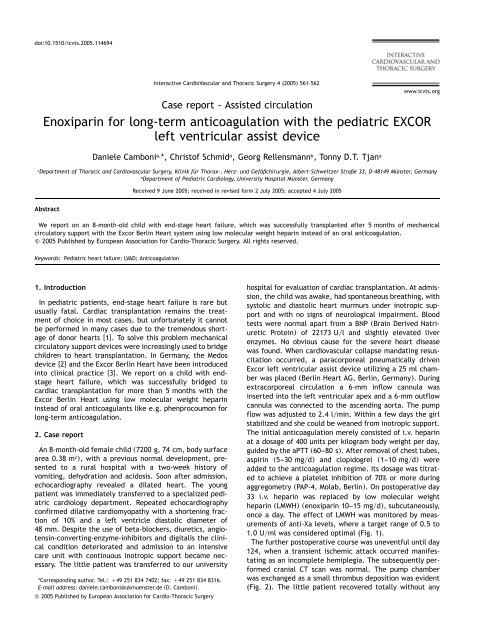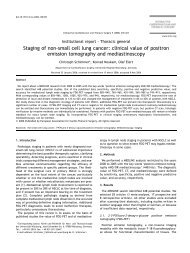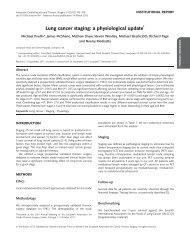Enoxiparin for long-term anticoagulation with the pediatric EXCOR ...
Enoxiparin for long-term anticoagulation with the pediatric EXCOR ...
Enoxiparin for long-term anticoagulation with the pediatric EXCOR ...
Create successful ePaper yourself
Turn your PDF publications into a flip-book with our unique Google optimized e-Paper software.
doi:10.1510/icvts.2005.114694<br />
� 2005 Published by European Association <strong>for</strong> Cardio-Thoracic Surgery<br />
ARTICLE IN PRESS<br />
Interactive CardioVascular and Thoracic Surgery 4 (2005) 561–562<br />
www.icvts.org<br />
Case report - Assisted circulation<br />
<strong>Enoxiparin</strong> <strong>for</strong> <strong>long</strong>-<strong>term</strong> <strong>anticoagulation</strong> <strong>with</strong> <strong>the</strong> <strong>pediatric</strong> <strong>EXCOR</strong><br />
left ventricular assist device<br />
a, a b a<br />
Daniele Camboni *, Christof Schmid , Georg Rellensmann , Tonny D.T. Tjan<br />
aDepartment<br />
of Thoracic and Cardiovascular Surgery, Klinik für Thorax-, Herz- und Gefäßchirurgie, Albert-Schweitzer Straße 33, D-48149 Münster, Germany<br />
bDepartment<br />
of Pediatric Cardiology, University Hospital Münster, Germany<br />
Abstract<br />
Received 9 June 2005; received in revised <strong>for</strong>m 2 July 2005; accepted 4 July 2005<br />
We report on an 8-month-old child <strong>with</strong> end-stage heart failure, which was successfully transplanted after 5 months of mechanical<br />
circulatory support <strong>with</strong> <strong>the</strong> Excor Berlin Heart system using low molecular weight heparin instead of an oral <strong>anticoagulation</strong>.<br />
� 2005 Published by European Association <strong>for</strong> Cardio-Thoracic Surgery. All rights reserved.<br />
Keywords: Pediatric heart failure; LVAD; Anticoagulation<br />
1. Introduction<br />
In <strong>pediatric</strong> patients, end-stage heart failure is rare but<br />
usually fatal. Cardiac transplantation remains <strong>the</strong> treatment<br />
of choice in most cases, but un<strong>for</strong>tunately it cannot<br />
be per<strong>for</strong>med in many cases due to <strong>the</strong> tremendous shortage<br />
of donor hearts w1x. To solve this problem mechanical<br />
circulatory support devices were increasingly used to bridge<br />
children to heart transplantation. In Germany, <strong>the</strong> Medos<br />
device w2x and <strong>the</strong> Excor Berlin Heart have been introduced<br />
into clinical practice w3x. We report on a child <strong>with</strong> endstage<br />
heart failure, which was successfully bridged to<br />
cardiac transplantation <strong>for</strong> more than 5 months <strong>with</strong> <strong>the</strong><br />
Excor Berlin Heart using low molecular weight heparin<br />
instead of oral anticoagulants like e.g. phenprocoumon <strong>for</strong><br />
<strong>long</strong>-<strong>term</strong> <strong>anticoagulation</strong>.<br />
2. Case report<br />
An 8-month-old female child (7200 g, 74 cm, body surface<br />
2<br />
area 0.38 m ), <strong>with</strong> a previous normal development, presented<br />
to a rural hospital <strong>with</strong> a two-week history of<br />
vomiting, dehydration and acidosis. Soon after admission,<br />
echocardiography revealed a dilated heart. The young<br />
patient was immediately transferred to a specialized <strong>pediatric</strong><br />
cardiology department. Repeated echocardiography<br />
confirmed dilative cardiomyopathy <strong>with</strong> a shortening fraction<br />
of 10% and a left ventricle diastolic diameter of<br />
48 mm. Despite <strong>the</strong> use of beta-blockers, diuretics, angiotensin-converting-enzyme-inhibitors<br />
and digitalis <strong>the</strong> clinical<br />
condition deteriorated and admission to an intensive<br />
care unit <strong>with</strong> continuous inotropic support became necessary.<br />
The little patient was transferred to our university<br />
*Corresponding author. Tel.: q49 251 834 7402; fax: q49 251 834 8316.<br />
E-mail address: daniele.camboni@ukmuenster.de (D. Camboni).<br />
hospital <strong>for</strong> evaluation of cardiac transplantation. At admission,<br />
<strong>the</strong> child was awake, had spontaneous breathing, <strong>with</strong><br />
systolic and diastolic heart murmurs under inotropic support<br />
and <strong>with</strong> no signs of neurological impairment. Blood<br />
tests were normal apart from a BNP (Brain Derived Natriuretic<br />
Protein) of 22173 Uyl and slightly elevated liver<br />
enzymes. No obvious cause <strong>for</strong> <strong>the</strong> severe heart disease<br />
was found. When cardiovascular collapse mandating resuscitation<br />
occurred, a paracorporeal pneumatically driven<br />
Excor left ventricular assist device utilizing a 25 ml chamber<br />
was placed (Berlin Heart AG, Berlin, Germany). During<br />
extracorporeal circulation a 6-mm inflow cannula was<br />
inserted into <strong>the</strong> left ventricular apex and a 6-mm outflow<br />
cannula was connected to <strong>the</strong> ascending aorta. The pump<br />
flow was adjusted to 2.4 lymin. Within a few days <strong>the</strong> girl<br />
stabilized and she could be weaned from inotropic support.<br />
The initial <strong>anticoagulation</strong> merely consisted of i.v. heparin<br />
at a dosage of 400 units per kilogram body weight per day,<br />
guided by <strong>the</strong> aPTT (60–80 s). After removal of chest tubes,<br />
aspirin (5–30 mgyd) and clopidogrel (1–10 mgyd) were<br />
added to <strong>the</strong> <strong>anticoagulation</strong> regime. Its dosage was titrated<br />
to achieve a platelet inhibition of 70% or more during<br />
¨<br />
aggregometry (PAP-4, Molab, Berlin). On postoperative day<br />
33 i.v. heparin was replaced by low molecular weight<br />
heparin (LMWH) (enoxiparin 10–15 mgyd), subcutaneously,<br />
once a day. The effect of LMWH was monitored by measurements<br />
of anti-Xa levels, where a target range of 0.5 to<br />
1.0 Uyml was considered optimal (Fig. 1).<br />
The fur<strong>the</strong>r postoperative course was uneventful until day<br />
124, when a transient ischemic attack occurred manifestating<br />
as an incomplete hemiplegia. The subsequently per<strong>for</strong>med<br />
cranial CT scan was normal. The pump chamber<br />
was exchanged as a small thrombus deposition was evident<br />
(Fig. 2). The little patient recovered totally <strong>with</strong>out any
ARTICLE IN PRESS<br />
562 D. Camboni et al. / Interactive CardioVascular and Thoracic Surgery 4 (2005) 561–562<br />
Fig. 1. Time course of anti-Xa levels during mechanical circulatory support.<br />
neurological impairment. A follow-up CT scan be<strong>for</strong>e discharge<br />
revealed a small hypodense subcortical lesion less<br />
than 1 cm in diameter. On day 154 of mechanical circulatory<br />
support a suitable donor organ was found and a<br />
successful orthotopic cardiac transplantation was<br />
per<strong>for</strong>med.<br />
3. Discussion<br />
Pediatric <strong>long</strong>-<strong>term</strong> mechanical support is challenging as<br />
bleeding and thrombembolic complications frequently<br />
occur w4x. This case offers different interesting in<strong>for</strong>mation.<br />
First of all, <strong>the</strong> <strong>pediatric</strong> Excor system allows mechanical<br />
support beyond 100 days <strong>with</strong> an acceptable risk. A comparable<br />
experience has been reported by <strong>the</strong> inventors of<br />
<strong>the</strong> Berlin Heart, which supported 18 children <strong>for</strong> a mean<br />
of 20 days w5x. We noticed a small thrombus deposition<br />
inside <strong>the</strong> pump chamber, which may occur early. As a very<br />
tiny thrombus deposition is empirically harmless and a<br />
pump exchange associated <strong>with</strong> certain risks (thrombus and<br />
air embolism!), we do not aggressively exchange pump<br />
chambers. Instead, we optimize <strong>anticoagulation</strong> and antiaggregation.<br />
Only in case of large thrombus <strong>for</strong>mation or<br />
after an adverse neurological event we exchange <strong>the</strong> pump<br />
chamber. In our case, <strong>the</strong> latter could be easily per<strong>for</strong>med<br />
on <strong>the</strong> intensive care unit <strong>with</strong>in a few minutes. Moreover,<br />
this case proves <strong>the</strong> possibility of using subcutaneous<br />
administered LMWH instead of coumadin or phenprocoumon<br />
as oral anticoagulants. Its efficacy can be monitored by<br />
measuring anti-Xa levels and kept ra<strong>the</strong>r stable over a <strong>long</strong><br />
Fig. 2. Exchanged pump chamber demonstrating a small thrombus deposition<br />
(arrow) underneath <strong>the</strong> outflow valve.<br />
period of time w6x. Additional platelet inhibition <strong>with</strong> aspirin<br />
and clopidogrel does not interfere.<br />
In conclusion, this case illustrates that LMWH could be a<br />
simple and reliable alternative during <strong>long</strong>-<strong>term</strong> support<br />
<strong>with</strong> <strong>the</strong> <strong>pediatric</strong> Excor system. Fur<strong>the</strong>r experience in a<br />
larger patient population is necessary to evaluate <strong>the</strong> safety<br />
of this new approach in comparison to <strong>the</strong> established<br />
<strong>anticoagulation</strong> strategies.<br />
References<br />
w1x Boucek MM, Novick RJ, Bennett LE, Fiol B, Keck BM, Hosenpud JD. The<br />
Registry of <strong>the</strong> International Society <strong>for</strong> Heart and Lung Transplantation:<br />
second official paediatric report-1998. J Heart Lung Transplant<br />
1998;17:1141–11460.<br />
w2x Throckmorton AL, Allaire PE, Gutgesell HP, Ma<strong>the</strong>rne GP, Olsen DB,<br />
Wood HG, Allaire JH, Patel SM. Pediatric circulatory support systems.<br />
ASAIO J 2002;48:216–221.<br />
w3x Hetzer R, Loebe M, Weng Y, Alexi-Meskhishvili V, Stiller B. Pulsatile<br />
<strong>pediatric</strong> ventricular assist devices: current results <strong>for</strong> bridge to transplantation.<br />
Semin Thorac Cardiovasc Surg Pediatr Card Surg Annu<br />
1999;2:157–176.<br />
w4x Weyand M, Kececioglu D, Kehl H, Schmid C, Loick HM, Vogt J, Scheld<br />
HH. Neonatal bridging to total orthotopic heart transplantation. Ann<br />
Thorac Surg 1998;66:519–522.<br />
w5x Stiller B, Hetzer R, Weng Y, Hummel M, Hennig E, Nadgyman N, Ewert<br />
P, Lemkuhl H, Lange P. Heart transplantation in children after mechanical<br />
circulatory support <strong>with</strong> pulsatile pneumatic assist device. J Heart<br />
Lung Transplant 2003;22:1201–1208.<br />
w6x Ho SH, Wu JK, Hamilton DP, Dix DB, Wadsworth LD. An assessment of<br />
published <strong>pediatric</strong> dosage guidelines <strong>for</strong> enoxiparin: a retrospective<br />
review. J Pediatr Hematol Oncol 2004;26(9):561–566.
















